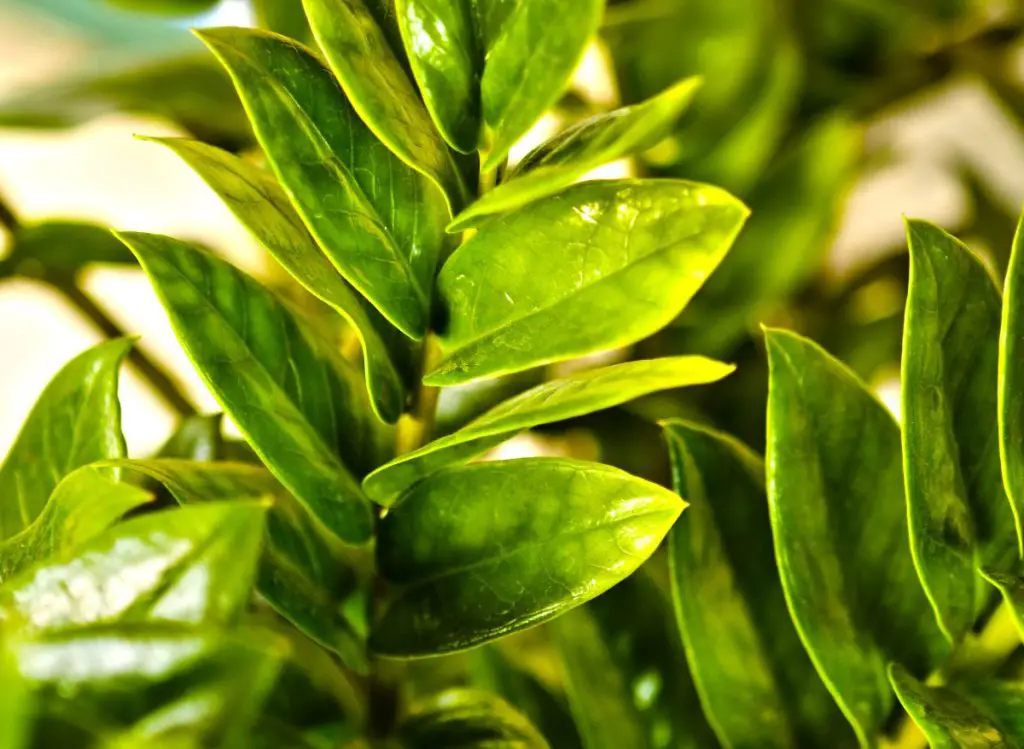
Have you ever seen a healthy ZZ plant with dark green leaves in your neighbor’s house or backyard and admired its beauty? These plants can breathe life into your interior décor and give your living room new meaning.
However, the leaves may turn brown if they are not well cared for. Leaves browning means your ZZ plant is severely distressed; if immediate action is not taken, your plant will die.
Why is your ZZ plant leaves turning brown? Your ZZ plant leaves are turning brown because of arid soil caused by poor watering. This condition is also the result of a lack of adequate lighting and humidity, planting in the wrong container, watering with polluted water, pest infestation, transplanting stress, and diseases.
If you severely neglect your ZZ plant, it will lack nutrients, and the leaves will turn brown. Let’s discuss these causes of leaves browning and how to correct them to salvage your house plant.
You might also enjoy reading: How Often To Fertilize ZZ Plant? (With the best fertilizers for ZZ plant)
What Causes Your ZZ Plant Leaves To Turn Brown And How To Fix Them?
There are several causes of ZZ plant leaves turning brown. One of the most typical causes of brown tips on ZZ plants is overwatering. Other causes include underwatering, overfertilizing, excess heat or light, or low humidity.
Here’s what causes your ZZ plant leaves to turn brown and how to fix them:
1- Poor Water Quality
We often avoid tap water rich in chlorine, fluoride, and salt because they affect our gut microbiome’s health and general well-being. Most house plants also do not thrive with tap water.
The ZZ plant is often adversely affected by some minerals, including chlorine, salt, and fluoride. These harmful substances are found in tap water, and when you use them to water the plants, they will be stressed.
Besides chlorine and fluoride affecting your ZZ plant’s health, tap water accumulates salt in the soil and roots of the plants. We know that salt absorbs water through Osmosis, which will draw moisture from the plant roots and the surrounding soil.
Your plants need water to survive; not water sapped from them! Accumulating useless minerals in the soil also affects the plant’s ability to draw nutrients, thus contributing to the browning of leaves.
How To Fix The Water Quality Problem:
- You want to stop using tap water when watering your ZZ plant because it has compromising chemicals. However, if tap water is the only water source in your region, you can install faucets with filters on your sink to remove damaging minerals.
- Alternatively, you can fetch tap water and keep it in the open overnight, thus allowing chlorine and fluoride chemicals to evaporate. The salt will also settle at the bottom, which you can decant and use for watering plants.
- Instead of tap water, you can tap rainwater or melted snow to water your ZZ plant. Rainwater does not have harmful chemicals; your plants will love it because it is what plants drink in the wild.
Note: Ensure the water you use, filtered, bottled, or from rain, is at room temperature. Cold or hot water will shock the plant and make the leaves fade, curl, and turn brown.
2- Failure To Water Or Overwatering
In the wild, ZZ plants rely on the natural water from the rain or stream to grow, but in your house, they look to you. Prolonged neglect and failure to water the plant produces arid soil and brown leaves.
The plant will lose water through evaporation; without moisture in the ground to replenish what is lost, your ZZ plant leaves will curl, dry up, and turn brown.
Overwatering will lead to roots rotting, and rotten roots cannot absorb water. It means that your ZZ plant could dry up in a pool of water because excess water drives out oxygen and aids fungal growth.
How To Fix An Underwatering Problem:
- Even though ZZ plants are drought-resistant, they still need regular watering to sustain their beautiful leaves. You may not need to water them like Calathea plants, but after every two weeks in the summer and three weeks in the winter, it is good to give them a drink.
- Of course, the amount of water you use in every watering session and the frequency also depend on the size of the plant. Huge ZZ plants need more water at a higher frequency than small ones.
- If you have overwatered your ZZ plant, drain the excess water by making more drainage holes in the potting container.
- Additionally, ensure you have a workable watering timetable to avoid overwatering or underwatering your plants.

3- Inadequate Humidity
Like Pilea plants and other house plants, ZZ plants excel in places with conducive humidity. Humidity has a significant bearing on the plant’s transpiration and its general health.
Fortunately, the ZZ plant is not demanding; it can thrive in places with relatively low humidity (less than 50%), underscoring why it is ideal for workplaces and homes.
However, when the humidity falls drastically and the surrounding air gets drier, your ZZ plant will lose excess water that it may not replace. Failure to replace the lost water often results in the wilting and browning of leaves.
Therefore, your house should have adequate humidity besides watering for a happy ZZ plant.
How To Fix Low Humidity:
- If you want to increase humidity in the house, you should regularly mist your plants. You could spray the plants with water, although this method only provides temporary solutions.
- The long-term solution could include incorporating a humidifier in your house. Fortunately, this method will benefit you and your plants.
- Alternatively, you could use a pebble tray with water to increase the amount of moisture in the house through evaporation. You can add gravel to the pebbles and keep your ZZ plant on top. This method helps with regular watering to supplement lost moisture without the risk of overwatering.
4- Direct Sunlight And Extreme Temperatures
ZZ plants love low light to aid in photosynthesis and energy generation. Therefore, direct sunlight is a no-no for them because it causes sunburn on the plant’s fragile leaves.
If you place the ZZ plants in the unguarded west or east-facing window, they will be hit by the scorching heat from the sun, contributing to browning leaves. The intense ultraviolet rays from the sun are not healthy for your indoor ZZ plant.
Additionally, extreme heat from the oven, desktop CPU, or other machines can cause your ZZ plant leaves to turn brown.
How To Fix The Problem:
- Since you know ZZ plants grow well with indirect light, you want to remove your plant pot from direct sunlight to a shady place where they can only access indirect light.
- You can also keep them in a dark room and use mirrors at the window to reflect indirect light to the plant’s leaves. And if you worry that part of the plant is not receiving enough sunlight, regularly rotate them so that the whole plant is well-cared for.
- Furthermore, ensure heat emitting machines are kept away from the plant to avoid unnecessary burns.
5- Transplantation Shock
ZZ plants often grow slowly, but eventually, they will outgrow their original home, hence the need for transplanting to a suitable pot.
However, the repotting process may result in plant shock and curling leaves, while in some instances, the leaves turn brown and die. This often happens if the replanting process is incorrectly done.
How To Fix Or Prevent Transplantation Shock:
Transplant your ZZ plant during the winter or spring seasons when the weather is favorable and less water is lost through transpiration. Transplanting during summer can be harsh on the plant, contributing to browning leaves.
The following steps will help you avoid excessive plant shock.
- Before transplanting, ensure you have the right pot size with a sound drainage system.
- Exercise care when removing the plant from its original home to avoid damage. You can use a gardening fork to dig the soil and lift the ZZ plant by the base to its new home.
- Prune any rotten or unhealthy roots.
- Replant and water slowly, but avoid overwatering.
- Bring the plant to the initial location to continue receiving the same light, humidity, and temperature.
- Cut off drying leaves and allow them to grow new ones.
Check out the video on how to properly transplant a ZZ plant.
6- Nutrient Deficiency
Did you know that plants also suffer from malnutrition with visible signs? If your ZZ plant is not getting essential nutrients, it will show in the browning leaves. Your plants need micro and macronutrients to grow their pretty admirable leaves.
Nutrient deficiency is often seen in the distortion and discoloration of the ZZs foliage. You will also notice stunted growth, signifying that the plant needs food.
How To Fix Nutrients Deficiency Problem:
- Sometimes malnutrition results from improper watering, so ensure your ZZ plant is correctly watered since moisture helps with nutrient absorption.
- You could also examine the soil’s pH value using a pH meter. If the soil pH is not within 6.0-7.0, it could affect nutrient absorption.
- You should also ensure the soil temperature is optimum for ideal nutrient uptake.
How Often Should ZZ Be Watered?
It is generally recommended to water a ZZ Plant every 2 to 3 weeks. However, ensure you allow the soil to dry out between waterings. Increase your watering frequency in brighter light and water less often in lower light.
Common signs that ZZ Plant is thirsty are
- wilting wrinkled leaves
- and dry potting mix.
In contrast, wet mix, yellowing, and mushy leaves are common overwatering and root rot signals. Dropping leaves can also be an overwatering sign. Hold off on watering and pruning your plant. Once the soil is fully dry through the pot, your plant is ready for a drink.
So, how do you know if your ZZ plant is getting too much light? Signs that your ZZ plant is getting too much light include ZZ plants’ leaves curling, ZZ plants’ leaves leaning away from the light, or ZZ plants’ leaves showing signs of yellowing. I suggest you add some shade or move your ZZ plant away from the light source.
Conclusion
ZZ plant leaves turning brown can be caused by various factors such as improper watering, nutrient deficiency, wrong pot size, transplant shock, poor water quality, and low humidity.
However, you can take practical steps to help your plant gain health and luxuriant leaves for a beautiful home. Sometimes it takes hard work, but the result will be worth it.
What to read next:
- Does Monstera Adansonii like to Be Rootbound? (When and How!)
- Is Your Watermelon Peperomia Drooping? (Here’s why and how to fix it!)
- How To Make Spider Plant Bushier (Here’s how!)
- Why Are The Tips of My Spider Plant Turning Brown? (Here’s how to fix it!)
- How Long Do Succulents Live Without Water (This long!)
- How To Deal With Splitting Lithops: Here’s How

